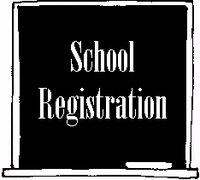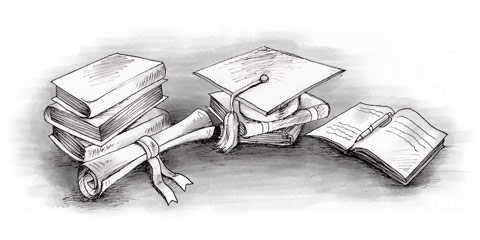Public schools are the responsibility of individual provincial departments of education and funded mainly from local and provincial taxes, with some federal funds. Practices and policies regarding education (public and private) vary depending on the province. Provincial departments of education determine education policy in accordance with provincial laws. The minister of education is responsible for setting policy relating to educational affairs, such as the allocation of provincial and federal funds, certification of teachers, textbooks and library services, provision of records and educational statistics, and setting and enforcing the term of compulsory education.
One of the unique aspects of the Canadian public school system is the amount of decentralisation and the degree to which schools are run by local school authorities. Each province is divided at the local level into school districts governed by a superintendent and a locally elected school board (or board of education) that decides instructional policies, hires teachers, purchases equipment and generally oversees the day-to-day running of schools. Most schools have Parents Advisory Councils (PACs) that mainly concern themselves with raising money to buy equipment such as computers, video surveillance, emergency lighting, playground equipment and school buses for children with special needs.
Teacher qualifications and standards vary from province to province. All provinces require teachers to have a licence or certificate to teach in public elementary and secondary schools, although the actual requirements for teacher certificates are set by provincial education departments. All provinces require a bachelor’s degree for teaching elementary grades and most require a bachelor’s degree as the minimum preparation for teaching in secondary schools, while a few insist on five years’ study or a masters degree. The full-time teaching force at primary and secondary level is around 310,000, with another 40,000 at universities and colleges. Parents are encouraged to participate in their child’s education and schools are constantly seeking volunteer ‘teacher’s assistants’ to help with reading, art and special projects.
Choosing a Public School
For most Canadian parents, one of the most important (if not the most important) criterion when choosing a new neighbourhood is the reputation of its public schools. This is often measured by the number of students schools send to the best Canadian universities (statistics are provided by all schools). In recent years there’s been an ongoing debate about school choice, which varies considerably depending on the city or province, e.g. in Edmonton (Alberta) parents can send their children to any school in the city and in Manitoba parents can choose any school in the province (provided there are spaces available).
However, in most areas it’s necessary to send your child to the public school that serves the area where you live and it’s difficult to get your child accepted at a public school in another area. For this reason, homes within the catchment area of desirable schools are in demand and more expensive. If you plan to send your child to a public school, you should make enquiries about the quality of local schools before deciding where to live. Often the more expensive property is in a neighbourhood, the better the local public schools. Relocation guides are published in many cities and regions, which usually include profiles of local schools and comparative scores for different grades. Many communities take pride in the quality of their local public school system, which is crucial in maintaining property values.
The quality of public schools varies considerably from province to province and community to community, and although some are poor, most are excellent. Where schools are well-run, well-supported and well-funded by the local community, the quality of public education rivals any in the world and can offer opportunities seldom available in many other countries. Even at schools where average standards are low, students who take full advantage of the opportunities afforded receive an excellent education.
Organisation
Most children start school before the age of six, when compulsory schooling usually begins, either in a nursery school or a kindergarten. The maximum 13 years of formal elementary and secondary education covers education from the ages of 5 to 18, divided into increments called grades (kindergarten and grades 1 to 12). Children usually start in kindergarten at the age of five and advance one grade per year until reaching grade 12 at age 18. Occasionally a student must repeat a grade due to prolonged absence or low marks, but this is rare.
A child can legally quit (drop out of) school at 16, but this is generally discouraged and the vast majority of students stay at high school until they reach the age of 18.
Age: Grade - School
2 to 5: - - Pre-school or Kindergarten
6 to 11: 1 to 6 - Elementary
12 to 14: 7 to 9 - Junior high
15 to 18: 10 to 12 - Senior high
Usually a student has one teacher for all major subjects during his first six years of schooling (elementary) and a different teacher for each subject during the last six grades in junior and senior high schools.
Registration

At elementary and secondary levels, students usually attend a public school close to their home. If you have a preference for a particular public school or school district, it’s usually necessary to buy or rent a property in that area, although you can request that your child attends a school outside your area (called ‘cross-boundary’). It’s quite normal for Canadians to ask an estate agent to find them a home in a particular school district. All schools prefer children to start at the beginning of a new term (semester), although this isn’t mandatory.
Parents should enquire at a school district’s central office or Board of Education to find out which school their child will be assigned to and the documents required for registration. Usually you need to produce proof of residence, an immigration record of landing, a passport, a birth certificate (or a certified copy) and details of your child’s medical history, including immunisations and tuberculin screening. It’s also necessary to provide past scholastic records, including a school report from your child’s last school. This is used to assign students to a class or grade and should be as detailed as possible, with samples of essays, projects and examinations.
Many towns provide transport to school (buses), although it may be provided for certain schools or ages only, and may depend on the distance, e.g. there may be a school bus only when the distance from your home to school is over 2 or 2.5 miles. Some towns provide buses for children in special education only.
Terms & School Hours
The school year in Canada usually runs from the first week of September until the end of June (ten months) and is divided into periods or quarters (terms/semesters). There are a few year-round schools and some that have a year that runs from mid-August to the end of May. School holiday dates are published by schools well in advance, thus allowing parents plenty of time to schedule family holidays during official school holidays. It isn’t advisable to take a child out of school when he should be taking examinations or during important course work assignments.
The school day in elementary schools is usually from 8.30am to 3 or 3.30pm, with an hour for lunch. There are also usually two 15-minute breaks (recesses) to allow students to let off steam between classes (and to allow teachers to find the aspirin). In high schools, hours are usually from 8.30am until 2.30pm. Extracurricular activities and sports are scheduled after school hours. Lessons in public schools are held from Mondays to Fridays and there are no lessons on Saturdays or Sundays. Canada also has what it calls ‘semestered high schools’, where instead of the standard eight subjects being taught throughout the year, four subjects are taught each term, with one long lesson (usually 70 minutes) on each subject each day. This system is thought to give a better understanding of each subject and to be more suitable for pupils who find it difficult to cope with eight subjects each week.
Health
In most provinces, school children must be immunised against a range of diseases before starting school. These may include polio, DTP (diphtheria, tetanus and whooping cough) and MMR (measles, mumps and rubella or German measles). Tuberculosis screening may also be necessary. Most schools have full or part-time nurses (who may cover a number of schools) or at the very least staff trained in administering first-aid. Special medical checks (physicals) are necessary to take part in some sports activities. Dental checks aren’t carried out at schools, but many schools promote a dental health week. Health education is provided in elementary and secondary schools, including sex education and graphic explanations of the perils of drugs and smoking (which are combined with community programmes). In many communities, volunteer ambulance corps members teach children about safety and accident prevention.
Pre-school Education
Pre-school education embraces all formal and informal education before the age of five (when compulsory schooling starts). It includes tots and toddler programmes, play school, nursery school and kindergarten. Attendance at school for children under five years of age isn’t compulsory in Canada, where pre-schools and nursery schools are private. However, kindergarten is part of the public school system and is compulsory for children aged five on 1st September, when they will start at the beginning of the school year in September.
There are various types of pre-schools in Canada, including non-profit co-operative schools, church-affiliated schools, local community schools, private schools and Montessori schools. A co-operative school is usually the least expensive as parents work voluntarily as teachers’ aides alongside professional teachers. Church-affiliated schools are usually attached to religious centres and may include religious education (it isn’t always necessary for children to follow the same religion as the school). Private schools are the most expensive and vary considerably from small home-run set-ups to large custom-built schools. A number of private nursery schools in Canada use the Montessori method of teaching, developed by Dr. Maria Montessori in the early 1900s. Montessori is more a philosophy of life than a teaching method and is based on the firm belief that each child is an individual with unique needs, interests and patterns of growth. Some Montessori schools have ‘pre-school’ (for children aged two and a half to six years) and elementary levels (ages 6 to 12).
Nursery school is highly recommended for all children, particularly those whose parents don’t speak English or French as their mother tongue. After a few years in nursery school a child is integrated into the local community and well prepared for elementary school (particularly when English or French isn’t spoken at home). Parents can also make friends in the community through pre-school contacts.
Elementary School
Children must start school on 1st September following their fifth birthday. The first years of compulsory schooling in Canada are called elementary or primary school. Elementary school is usually mixed and is usually attended until age 11 (grades 1 to 6), when students go on to a junior high school. In some districts, students attend elementary school until age 13 (up to grade 8) before attending a senior high school.
The elementary school curriculum varies with the organisation and educational aims of individual schools and local communities. Promotion from one grade to the next is based on testing and a child whose performance is poor may be required to repeat a year, while a gifted child may be allowed to skip a year. Elementary schools provide instruction in the fundamental skills of reading, writing and maths, as well as history, geography, crafts, music, science, art, and physical education (phys ed. or gym). French and ‘foreign’ languages, which used to be taught only at high schools, are now introduced during the last few years of elementary school in some areas and, if you wish, your child can enter an ‘early French immersion programme’ at kindergarten or grade 1 level. For more information contact the local branch of the ‘Canadian Parents for French’ programme.
Secondary School
Secondary education in Canada is for children aged from 12 to 18 (grades 7 to 12). It generally takes place in a high school, that may be divided into junior and senior high (held in separate buildings or even at separate locations). Junior high is for those aged 12 to 14 (grades 7 to 9) and senior high for ages 15 to 17 (grades 10 to 12). In Quebec, students attend high school for grades 7 to 11 and then transfer to a general and vocational college (collége d’enseignement général et professionnel/CEGEP) for a further two or three years. Like elementary education, secondary education is mixed.

Secondary schools may specialise in academic or vocational streams or the arts; all include some kind of ‘streaming’ system that’s designed to prepare students for a vocational or community college or university. Mandatory or ‘core’ curriculum subjects must be studied for a prescribed number of years or terms, as decided by each province. These generally include English (French), maths, general science, health, sport (physical education) and social studies or social sciences (which may include Canadian history and government, geography, world history and social problems). In addition to mandatory subjects, students choose optional subjects (electives) that will benefit them in the future.
Electives usually comprise around half of a student’s work in grades 9 to 12. Around the ninth grade, students receive career guidance counselling as they begin to plan their careers and select subjects that will be useful in their chosen fields. Counselling continues throughout the senior high school years and into college. Larger schools may offer a selection of elective courses aimed at three or more levels: academic, vocational and general. Students planning to go on to college or university elect courses with an emphasis on academic sciences (biology, chemistry, physics), higher mathematics (algebra, geometry, trigonometry and calculus), advanced English or French literature, composition, social sciences or foreign languages.
The vocational programme may provide training in four fields: agricultural education which prepares students for farm management and operation; business education which trains students for the commercial field; home economics which prepares students for home management, child care and care of the sick; and trade and industrial education which provides training for jobs in mechanical, manufacturing, building and other trades. Students interested in entering business from high school may take typing, book-keeping, computer studies or ‘business’ English or French.
School sports are popular in Canada, although most take place outside school hours (extracurricular). Team sports have a high profile at high school and being ‘on the school team’ is more important to many students than being top of the class. Students who excel at sports are often referred to disparagingly as ‘jocks’, implying that they’re too stupid or lazy to succeed at their academic work. However, if a student’s grades don’t reach the required level he’s likely to be barred from taking part in team sports until his grades improve (and he’s constantly monitored). High school sport is central to school activities and the ceremony that goes with college sport is also found at high-school level.
In addition to sports, many other school-sponsored activities take place outside school hours, including science and nature clubs, musical organisations (e.g. band and choir), art and drama groups, and language clubs. Most high schools have a student-run newspaper and a photographic darkroom is also usually available. Colleges and universities place considerable weight on the achievements of students in high school extracurricular activities, as do Canadian employers. High schools are also important social centres and participation in school-organised social events, such as school dances and the first hockey game of the season, is widespread.
Examinations & Grades
When a student enrols in a public school, a ‘record file’ is opened for him (which follows him throughout his school years) and there’s a continuous evaluation system throughout all grades. Students are marked on each essay (paper), exam and course taken in each subject studied throughout their 13 years of education (grades K to 12). The following grading system is used in high schools throughout Canada:
Grade: Classification - Percentage
A: Excellent - 90 to 100
B: Good - 80 to 89
C: Average/fair - 70 to 79
D: Poor - 60 to 69
F: Fail - Below 60
All grades are internal and are in relation to the general standard achieved at a particular school, which usually makes it difficult to compare standards in different schools and provinces. Marks depend on a range of criteria, including a student’s performance in tests given at intervals during the year, participation in class discussions, completion of homework assignments, and independent projects. Students receive a report card at least twice per year (in some districts it may be up to six times per year), which shows their grades in each subject they’re studying.
High school students who need to make up for lost time after illness (or idleness) can attend special ‘cramming’ courses at learning centres run by private companies such as the Sylvan Learning Centre, which has centres in most large towns in Canada (see your yellow pages or www.educate.com ). High schools divide their curriculum into ‘advanced’, which prepares students to go to university, or ‘general’, which prepares students to go to a community college or trade school.
High school students take the General Educational Development (GED) Diploma before completing high school, which is the recognised entrance qualification for admission to a Canadian university (mature students aged 25 or over can take GED ‘equivalency exams’ if they haven’t passed the GED).

